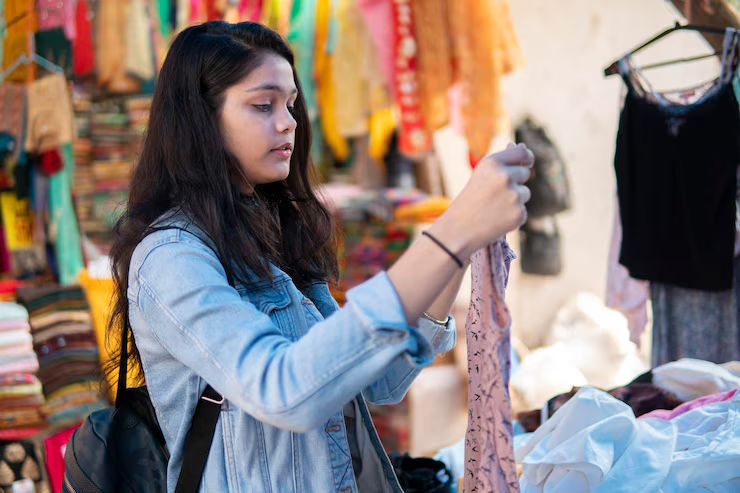Contents
- 1 That feeling you get when your clothes fit just right
- 2 First, figure out what shape your body is.
- 3 Frequently asked questions
- 3.1 Question 1: How do I know what size to buy online?
- 3.2 Q2: What if I’m not sure what size to get?
- 3.3 Have different brands different rules about what sizes work?
- 3.4 Q4: What role does cloth play in picking the right fit?
- 3.5 Q5: Can I return or swap clothes that don’t fit?
- 3.6 Q6: If I’m not sure, what kind of fit should I look for?
- 3.7 7. Is it worth the money to buy clothes that are made to fit you perfectly?
That feeling you get when your clothes fit just right
We’ve all had that one outfit. It’s the one that makes you smile when you look in the mirror, and it looks like it was made just for you. It’s possible to feel better, have more confidence, and have a smoother day when your clothes fit just right. Unfortunately, most of us wear clothes that are too tight, too loose, or just plain uncomfortable because we don’t know how to find the right fit.
Good news, though: it’s not as hard as you think. Because you know your body, shop smart, and pick fabrics that fit your shape, you’ll more likely than not get the right fit. You don’t have to wait around in trial rooms for hours or risk risky internet returns. You just need to take the right steps.
First, figure out what shape your body is.
Start by figuring out what kind of body you have. Figuring out your shape will help you choose cuts and styles that make your features look better. If you naturally have wider shoulders, a defined waist, or fuller hips, your clothing should support and show them off.
In tight clothes, stand in front of a mirror and look at your proportions. Figure out where your clothes feel tight or loose on you. Find out your shoulder width, bust, waist, and hip sizes. Write these numbers down or save them to your phone. Most fashion sites, like Myntra and Zivame, let you use your measurements to find the right size.
You can choose the right shapes if you know where your weight or length falls. For instance, peplum tops make midsections look smaller, and straight-fit pants make bigger frames look better. It’s about looking good and being relaxed.
Labels aren’t as important as size charts.
Size tags not always tell the truth. In some brands, a “Medium” might fit like a “Large.” That’s why you shouldn’t depend on numbers or letters alone. You should always look at the brand’s size chart and match it to your own body measurements. Sites with a good reputation, like Ajio, Amazon Fashion, and Nykaa Fashion, show accurate product sizes with bust, hip, and shoulder measurements.
You can also find help in customer reports. It’s helpful to know if something is “true to size” or “runs small” because a lot of people say those things. It’s a good sign if more than one reader says the shoulders are too tight or the waist is too loose.
Reading carefully about the size only takes a minute, but it can save you hours of returns and sadness.
Pick the Right Fabric for Your Size
It really does matter what kind of fabric you use. If you buy the same dress in cotton and polyester, they may not fit at all. Some things need to be able to breathe, grow, or shrink. You can choose whether to go up a size, stick to your measurements, or skip a piece if you know how it will behave.
Cotton-blends, jersey knits, and modal are all good fabrics for warmth and stretch. Things made of linen, denim, and thick cotton don’t usually give much, so clothes made of them should fit well from the start.
Levi’s has jeans with shaping technology that you should check out if you’re looking for jeans. For regular wear, look through Tata CLiQ for brands that sell basics made of cotton and tailored pieces with clear information about the fabric.
Try it on or make it fit you better.
Try on clothes before you buy them if you can. Move around in them. Bend over and raise your arms. Good clothes should feel great when you move too, not just look good when you’re not moving. If you buy something online, make sure it’s easy to return it. This is especially important for fashion sites like Flipkart that make swaps easy.
Also, don’t forget how powerful tailoring can be. A small change is sometimes all that stands between you and a perfect fit. A tailor can do great things if the length is off or the waist needs an inch less. In fact, a lot of shops in the area now offer fitting while the clothes are being delivered.
There are also services, like The Pant Project, that do custom sizing and let you make pants at home using your exact measures.
Related: Exciting New Game Ideas You Can Try Today
Shopping habits that are good for you and your health
You can use the filters on the website. Words like “stretch,” “relaxed fit,” and “slim fit” will help you figure out how a piece will feel.
Save your data now and update them every two months.
Don’t buy clothes that you think you’ll “grow into.” They should fit you now.
Spend money on a few basic pieces that will always look good on you.
Know When to Give Up
You won’t wear something that doesn’t fit, even if it’s trendy or on sale. Stay away from the mistake of keeping clothes that don’t fit right. It shouldn’t be hard to get dressed because of your room. If you keep tugging, pulling, or hiding something under layers because it needs to be changed all the time, it’s time to move on.
Fit is the first step to great style. It doesn’t matter how bright the color is or how much the label costs. How sure, relaxed, and at ease you feel in it is what matters.
Frequently asked questions
Question 1: How do I know what size to buy online?
Always check the brand’s size chart and match your measurements to the ones they give you for bust, waist, hips, and inseam. Tools like Myntra’s Fit Assistant can help you figure out what size you should wear in different brands.
Q2: What if I’m not sure what size to get?
If you’re not sure what size to get, think about the fabric. If it gets bigger, pick the smaller one. If it’s stiff, get the bigger one and make some changes. A good way to make clothes fit like they were made just for you is to have them tailored.
Have different brands different rules about what sizes work?
Yes, each brand makes its own size chart. So, a size M from one brand might feel like a size L from another. Always look at size charts on websites like Ajio and Nykaa Fashion.
Q4: What role does cloth play in picking the right fit?
Very important. There are fabrics that don’t bend and shape to your body, and fabrics that do. Cotton-stretch mixes are easy to wear every day, but denim and linen need to be sized correctly.
Q5: Can I return or swap clothes that don’t fit?
Most of the best fashion sites, like Amazon Fashion and Flipkart, make it easy to return or swap items. Check the return window every time before you buy something.
Q6: If I’m not sure, what kind of fit should I look for?
If you’re not sure, a regular or relaxed fit is generally a good choice. It makes you feel good while still giving you an organized look. You can always use a belt or a tailor to make small changes.
7. Is it worth the money to buy clothes that are made to fit you perfectly?
Of course. Fitted clothes look better and last longer. Custom-fit choices are available on sites like The Pant Project. They aren’t always expensive but give great results.
Disclaimer: This blog is for informational purposes only. The product and site mentions are examples for guidance and not endorsements.





